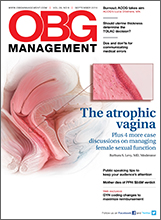
“IN WHICH CLINICAL SITUATIONS CAN THE USE OF THE 52-MG LEVONORGESTREL-RELEASING IUD (MIRENA) AND THE TCU380A COPPER-IUD (PARAGARD) BE EXTENDED?”
ROBERT L. BARBIERI, MD (SEPTEMBER 2016)
Extended-use IUDs and infection risk
For some time now I have been leaving hormonal intrauterine devices (IUDs) in place for 6 to 7 years, until menses returns. In my practice, long-term use of copper-IUDs has been associated with the presence of actinomycosis in the endometrial cavity, although usually without sepsis.
George Haber, MD
Montreal, Canada
Suppressing menses, pain with an IUD
I have a number of patients using the 52-mg levonorgestrel-releasing (LNG) IUD (Mirena) for noncontraceptive reasons, especially for reduction or elimination of menstrual flow and/or pain. Many have permanent sterilization in place (tubal sterilization, partner vasectomy) and I tell them we can leave the IUD in as long as they are satisfied with the results, since we are not concerned with pregnancy. Several have continued IUD use well past the 5-year mark.
Alan Smith, MD
Savannah, Georgia
LNG-IUD effective for multiple uses
In our practice, we have used the LNG-IUD Mirena off label for over a decade successfully for men-strual suppression in perimenopausal and postmenopausal women effectively for up to 8 years. We often place this device in the uterus after an endometrial ablation. We also offer it extended use as an alternative for menopausal hormone therapy when a progestin is indicated due to the presence of a uterus. Progestin delivery by this IUD is maximized in the endometrium and minimized in the breast and other systemic sites.
John Lenihan Jr, MD
Tacoma, Washington
Dr. Barbieri responds
I thank Dr. Haber for his observations. He notes that users of IUDs may have Actinomyces organisms identified on cervical cytology. These women should be informed of the finding and examined for evidence of active pelvic infection. If the women are asympto-matic and have a normal physical exam, the IUD does not need to be removed and antibiotic treatment is not recommended. If the woman has evidence of pelvic infection, the IUD should be removed and sent for anaerobic culture.
I appreciate that Drs. Smith and Lenihan shared their clinical pearls with readers. Dr. Smith notes that when an LNG-IUD is used to control bleeding in women who are sterilized, there are few concerns about the duration of its contraceptive efficacy, and adequate control of bleeding is a clinically useful end point demonstrating the IUD’s continued efficacy. If bleeding begins to increase after 5 years, the clinician might choose to remove the old device and replace it with a new one. Dr. Lenihan reports his use of the 52-mg LNG-IUD as the progestin in a regimen of menopausal hormone therapy. Of note, there are multiple reports from Finland that use of an LNG-IUD in premenopausal and menopausal women may be associated with an increased risk of breast cancer.1,2 Conflicting reports from Finland and Germany did not detect an increased risk of breast cancer in women who used an LNG-IUD.3,4 Clinicians should be aware that when Mirena is used past its approved 5-year time limit, it is an off-label use of the device.
Share your thoughts! Send your Letter to the Editor to rbarbieri@frontlinemedcom.com. Please include your name and the city and state in which you practice.

